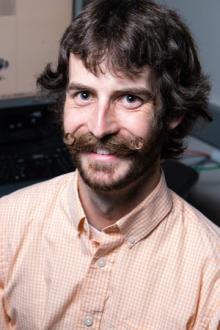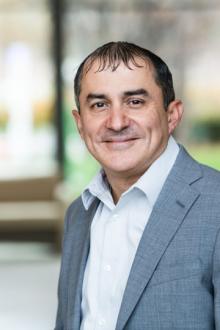SnT2023
Join researchers from PNNL at the Science and Technology Conference 2023 (SnT2023) as they present findings from their latest research at the international event, held in Vienna, Austria, and online from June 19-23, 2023.

Image by Jeff London | Pacific Northwest National Laboratory
Vienna, Austria
The event is expected to bring together more than 1,000 researchers, scientists, technologists, academics, and youth group members to discuss the key conference themes. These themes include the Earth as a complex system; monitoring and on-site inspection technologies and techniques; sustainment of networks, performance evaluation, and optimization; and the Comprehensive Nuclear-Test-Ban Treaty in a global context.
Many researchers from Pacific Northwest National Laboratory (PNNL) will be participating in this year's conference and would like to meet you. And if you're a scientist or engineer interested in working at PNNL, check out our current openings in:
PNNL Presentations by Research Area
T1.1 THE ATMOSPHERE AND ITS DYNAMICS
Presentation: Design of an Atmospheric Radiotracer Experiment to Improve Local-scale Transport Modeling

PNNL Authors: Cari Seifert (presenter), Lynn Wood, Michael Foxe, Sean Stave, Marty Keillor, Chris Johnson, Michael Moore, and Rob Newsom
Summary: Understanding the impacts of near-field air flow on the long-range transport of radionuclides in the atmosphere after a release from an underground nuclear event requires improved modeling at the local scale. In this work, we present the design of a radiotracer experiment in a complex terrain environment in support of modeling improvements. A remotely controlled release of Xe-127 gas, produced from neutron irradiation of isotopically enriched Xe-126, provides a radiotracer plume that can be detected by an array of real-time NaI(Tl) sensors out to 5 km from the release point. Whole-air sampler systems collect gas for later laboratory analysis. A simultaneous smoke release permits tracking of the plume using scanning lidar instruments. An array of meteorological towers provides high-resolution wind field data to feed forward- and back-tracking atmospheric transport models. We will present the design of the experiment and the major elements thereof, including tracer sources, sensors, and samplers.
e-Poster: Design of a Real-time Radiation Sensor Network for Atmospheric Radiotracer Experiments
PNNL Author: Sean Stave
T1.2 THE SOLID EARTH AND ITS STRUCTURE
e-Poster: Novel Rock Evaluation for Field-scale Geological Modeling using Joint Inversion of ECT and p-wave Velocity Measurements
PNNL Author: Justin Lowrey
e-Poster: Measuring Explosively Driven Elemental Diffusion in Geological Matrices as Potential Signatures
PNNL Author: April Carman
e-Poster: Measurements of Ar-39 in Shallow Surface Soil
PNNL Author: Brian Milbrath
T2.4 ATMOSPHERIC AND SUBSURFACE RADIONUCLIDE BACKGROUND AND DISPERSION
Presentation: Potential Impact of Molten Salt Reactors on Radionuclide Stations of the International Monitoring System

PNNL Authors: Johnathan Slack (presenter), Chris Johnson, Manish Sharma, Ches Simpson, and Jonathan Burnett
Summary: Molten Salt Reactors (MSRs) are a Generation IV nuclear reactor design that is currently under development and testing in various countries around the world. The molten fuel provides an opportunity for continuous processing of gaseous fission products, which may impact the International Monitoring System (IMS). Simulations were performed for four MSR designs to predict the production of IMS-relevant radionuclides during batch and continuous reprocessing schemes. Radioxenon and radioiodine signatures were drawn from these simulations and compared to current reactor designs (boiling water reactor, pressurized water reacter, and RBMK [reaktor bolshoy moshchnosty kanalny, or high-power channel reactor]). In the case of continuous reprocessing of the fuel salt, the radioxenon and radioiodine signatures were found to be indistinguishable from those of a nuclear explosion.
Presentation: Argon-37 Field System Measurements

PNNL Author: James Hayes
Summary: This presentation will highlight background measurements of 37Ar samples that were conducted in Knoxville, Tennessee, United States to better understand the sources of atmospheric concentrations of 37Ar using the Argon-37 Field System. The PNNL-designed and built Argon-37 Field System has now processed and measured several hundred 37Ar samples from both soil gas and the atmosphere. The system was designed to process whole air samples from soil gas, atmosphere, and the output of radioxenon systems to detect 37Ar in an above-ground portable system. During this campaign, samples were collected at a location, near Xenon International, and sent back to PNNL for processing and measurements, as opposed to sending the system to a location and operating it remotely. Correlation with radioxenon measurements from the same air mass was conducted and will be discussed.
e-Poster: Radioxenon Isotopes, Ratios, and Discrimination: Challenges and Opportunities
PNNL Author: James Ely
e-Poster: Comparison of Radioxenon Signals from a Nuclear Explosion and Alternative Background Sources
PNNL Author: Michael Foxe
e-Poster: Radioxenon Emissions from Nuclear Power Plants and Medical Isotope Production Facilities measured in the STAX Project
PNNL Author: Judah Friese
e-Poster: STAX Data Viewing Software
PNNL Author: Mattias Auer/ISTI
e-Poster: Successes in the Monitoring of Noble Gas Backgrounds at the Release Source
PNNL Author: Lori Metz
e-Poster: Assessing Local Variability of Radon Backgrounds in the Subsurface using High Density Field Measurements
PNNL Author: Justin Lowrey
e-Poster: Detection and Analysis of Anomalous Radioxenon Isotopes
PNNL Author: Michael Mayer
T3.2 RADIONUCLIDE TECHNOLOGIES AND APPLICATIONS
Presentation: Next Generation Beta-Gamma Coincidence Detectors with Increased Capability

PNNL Authors: James Ely (presenter), Dick Kouzes, Todd Hossbach, and Matt Cooper
Summary: The beta-gamma coincidence method is used to detect and measure radioxenon isotopes in the field, greatly reducing the background and increasing sensitivity. Research has been performed to explore further background reduction using spatial information provided by pixelated, voxelated, or segmented detectors. This includes segmented and pixelated silicon detectors for beta or electron detection and voxelated cadmium-zinc-telluride detectors for gamma or x-ray detection. Segmentation or pixelation, in addition to providing spatial information, reduces the detector capacitance, allowing for lower thresholds at room temperature, and providing access to low-energy beta, electron, and x-rays. With higher levels of pixelation, such as in a charge-coupled device, the spatial information can provide particle identification, providing discrimination of alphas and muons from the beta and gamma signals of interest. The potential for increased sensitivity will be presented along with measurements from prototypical detectors.
Presentation: Impact of Nuclear Detector Technologies on Radioxenon Laboratory Operation

PNNL Authors: Michael Foxe (presenter), Ted Bowyer, Ian Cameron, James Hayes, Michael Mayer, Jennifer Mendez, Rose Perea, and Johnathan Slack
Summary: Recent efforts have explored the use of high-resolution beta detectors for improved metastable isomer discrimination. These detectors have been focused on implementation within the International Monitoring System (IMS) stations for the detection of all four radioxenon isotopes. The duration between collection and measurement is increased for radioxenon laboratories. Based on the shipping duration and sample type (spike versus environmental sample), there may only be Xe-133 and Xe-131m present in samples that are sent from an IMS station. Depending on the isotopes present, there is the potential that the choice of nuclear detector may be preferential for one type over another. In this presentation, we evaluate the implementation of plastic scintillator beta cells and silicon beta cells for radionuclide laboratory operations. As part of this, we evaluate the impact of potential sample activities and isotopic ratios.
e-Poster: Factors Affecting the Vertical Distribution of Background at IMS Stations
PNNL Author: Ted Bowyer
e-Poster: Development of a Continuous Field Xenon Detection Systems
PNNL Author: Chris Johnson
e-Poster: Silicon Beta Cell Performance Improvements using Silicon Photomultiplier Well Detectors for Beta-gamma Radioxenon Systems
PNNL Author: Johnathan Slack
e-Poster: A Small, Portable Electrostatic Precipitation-based Radio-aerosol Monitor
PNNL Author: Marty Keillor
e-Poster: Development and Validation of Coincidence Analysis/quantification Software for Gamma-gamma Coincidence Counting
PNNL Author: Manish Sharma
e-Poster: RASA 2.0: A Next Generation Aerosol Sampler/Analyzer
PNNL Author: Harry Miley
e-Poster: Xenon International Phase 2 Testing
PNNL Author: Jim Hayes
T3.3 ON-SITE INSPECTION TECHNIQUES
Presentation: A Comparison of Portioning Samples Under the Comprehensive Nuclear-Test-Ban Treaty Organization, the Organisation for the Prohibition of Chemical Weapons and the International Atomic Energy Agency

PNNL Author: Brian Milbrath
Summary: The Comprehensive Nuclear-Test-Ban Treaty (CTBT) language on an Inspected State Party’s right to portions of samples taken during an on-site inspection (OSI) is very similar to sampling language in the Chemical Weapons Convention (CWC), reflecting an overlap amongst negotiators involved. There are small differences in the treaties’ wordings, however, and in the case of the CTBT these differences have made it difficult for state signatories to reach consensus on how to implement portioning of samples during an OSI. Meanwhile the CWC has been in force for 25 years, during which time the OPCW has developed procedures for inspectors to portion samples, though not all aspects of inspections or portioning have been fully exercised. Likewise, International Atomic Energy Agency (IAEA) inspectors take samples during inspections, and while the concept of portioning may not be as explicit, procedures allow for the Inspectorate of Strategic Products (ISP) to retain their own relevant samples. We examine how the ISP right to sample portions is practiced at the Organization for the Prohibition of Chemical Weapons and IAEA and draw insights from their experiences to compare with the approaches considered at Preparatory Commission meetings.
T3.4 INTEGRATING DATA FROM DIFFERENT MONITORING TECHNOLOGIES
e-Poster: Developments toward a Radionuclide Event Computational Pipeline
PNNL Author: Brian Schrom
T3.6 ANALYSIS OF RADIONUCLIDE MONITORING DATA
e-Poster: The Development of an Association Algorithm for Radionuclide Measurements
PNNL Author: Paul Eslinger
e-Poster: Radioxenon Uncertainty Model
PNNL Author: Matthew Cooper
e-Poster: Neural-Network Based Isotope Estimation with Iterative Curve Fitting
PNNL Author: J.R. Powers-Luhn
e-Poster: Long-Term Radioxenon Detector Background: 1st year Results
PNNL Author: Rose Perea
T4.2 SYSTEMS ENGINEERING FOR INTERNATIONAL MONITORING SYSTEM AND ON-SITE INSPECTION
e-Poster: Development of a Modernized Radionuclide Laboratory System to Support the New Generation of IMS Systems
PNNL Author: Michael Foxe
T4.4 INTERNATIONAL MONITORING SYSTEM SUSTAINMENT
Presentation: Advancements in State of Health Monitoring - Current and Future Developments

PNNL Authors: Rey Suarez (presenter), Ian Cameron, James Hayes, Daniel Keller, Jan Strube, Ryan Wilson
Summary: State of health (SOH) data from sensors of radionuclide systems in the International Monitoring System (IMS) can provide critical information about the overall operating status of stations. Since radionuclide systems may have a large number of sensors, most SOH algorithms monitor a key subset of sensors for failures so that operators can take corrective actions. Another important aspect of SOH monitoring is to analyze all the sensor data so that subtle changes might be indicative of a progressively growing problem. The other question to answer is, are all the right sensors in place to strategically classify and identify failures early? Over the past several years, Pacific Northwest National Laboratory, in collaboration with General Dynamics, has been developing a software architecture for analyzing SOH data from radionuclide systems in the IMS. The architecture was originally developed to support the Swedish Automatic Unit for Noble Gas Acquisition, then the Radionuclide Aerosol Sampler/Analyzer was added. The architecture that supports the IMS2.0 format, is dynamic in terms of the number of sensors, and can use different algorithms in parallel for monitoring different subsets of sensors. Since the SOH architecture is versatile, it can be used to research and test new algorithms. New research seeks to detect signatures of failures early as well as identify new sensors that may provide critical insight into the health of key components. This presentation will describe new advancements in the SOH monitoring architecture as well as highlight current and future research related to SOH monitoring in the IMS.